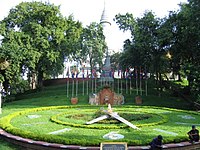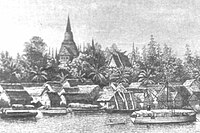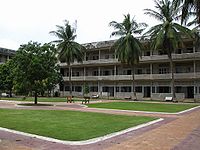Friday, March 15, 2013
ក្រុងភំ្នពេញ
Phnom Penh (/pəˈnɒm ˈpɛn/ or /ˈnɒm ˈpɛn/; Khmer: ភ្នំពេញ, Khmer pronunciation: [pnum pɨɲ]) is the capital and largest city of Cambodia. Located on the banks of the Mekong River, Phnom Penh has been the national capital since French colonization of Cambodia,
and has grown to become the nation's center of economic and industrial
activities, as well as the center of security, politics, cultural heritage, and diplomacy of Cambodia.
Once known as the "Pearl of Asia", it was considered one of the loveliest French-built cities in Indochina[2] in the 1920s. Phnom Penh, along with Siem Reap and Sihanoukville,
are significant global and domestic tourist destinations for Cambodia.
Founded in 1434, the city is noted for its beautiful and historical
architecture and attractions. There are a number of surviving French colonial buildings scattered along the grand boulevards.
Situated on the banks of the Tonlé Sap, Mekong and Bassac rivers, the Phnom Penh metropolitan area is home to about 2.2 million [1] of Cambodia's population of over 14.8 million, up from about 1.9 million in 2008.[3] The city is the wealthiest and most populous city in Cambodia and is the country's political hub.
Etymology
Phnom Penh (literally, "Penh's Hill") takes its name from the present Wat Phnom ("Hill Temple"). Legend has it that in 1372, an old nun named Lady Penh went to fetch water in the Mekong and found a dead Koki tree floating down the stream. Inside a hole of the Koki tree were four bronze and one stone Buddha statues.
Daun (Grandma) Penh brought the statues ashore and ordered people to
pile up earth northeast of her house. She then used the Koki trunks to
build a temple on the hill to house the five Buddha statues, and named
the temple after herself as Wat Phnom Daun Penh, which is now known as
Wat Phnom, a small hill of 27 metres (89 ft) in height.
Phnom Penh was also previously known as Krong Chaktomok (Khmer: ក្រុងចតុមុខ) meaning "City of Four Faces". This name refers to the junction where the Mekong, Bassac, and Tonle Sap rivers cross to form an "X" where the capital is situated. Krong Chaktomuk is an abbreviation of its ceremonial name which was given by King Ponhea Yat, which in full is Krong Chaktomuk Mongkol Sakal Kampuchea Thipadei Sereythor Inthabot Borei Roth Reach Seima Maha Nokor (Khmer: ក្រុងចតុមុខមង្គលសកលកម្ពុជាធិបតី សេរីធម៌ ឥន្រ្ទបទបុរី រដ្ឋរាជសីមាមហានគរ).
This ceremonial name is composed from Pali, and loosely translates as "The place of four rivers that gives the happiness and success of Khmer Kingdom, the highest leader as well as impregnable city of the God Indra of the great kingdom".[4]
History

Wat Phnom gave the city its name
First recorded a century after it is said to have taken place, the
legend of the founding of Phnom Penh tells of a local woman, Old Lady
Penh (Duan Penh,) living at the chaktomuk, the future Phnom Penh. It was
the late 14th century and the Khmer capital was still at Angkor near
Siem Reap 350km to the west. Gathering firewood along the banks of the
river, Lady Penh spied a floating koki tree in the river and fished it
from the water. Inside the tree she found four Buddha statues and one of
Vishnu (the numbers vary on different tellings.)
The discovery was taken as a divine blessing, and to some a sign that
the Khmer capital was to be brought to Phnom Penh from Angkor. To house
the new found sacred objects, Lady Penh raised a small hill on the west
bank of the Tonle Sap River and crowned it with a shrine, now known as
Wat Phnom at the north end of central Phnom Penh. 'Phnom' is Khmer for
'hill' and the Lady Penh's hill took on the name of the founder, i.e.
Phnom Duan Penh, and the area around it became known after the hill -
Phnom Penh. Phnom Penh first became the capital of Cambodia after Ponhea Yat, king of the Khmer Empire, moved the capital from Angkor Thom after it was captured and destroyed by Siam a few years earlier. There is a stupa behind Wat Phnom that house the remains of Ponhea Yat and the royal family as well as the remaining Buddhist statues from the Angkorean era. In the 17th century, Japanese immigrants also settled on the outskirts of present-day Phnom Penh.[5] A small Portuguese community survived in Phnom Penh until the 17th century, undertaking commercial and religious activity in the country.
Phnom Penh remained the royal capital for 73 years—from 1432 to 1505.
It was abandoned for 360 years—from 1505 to 1865—by subsequent kings
due to internal fighting between the royal pretenders. Later kings moved
the capital several times and established their royal capitals at
various locations in Tuol Basan (Srey Santhor), Pursat, Longvek, Lavear Em and Udong.
It was not until 1866, under the reign of King Norodom I (1860–1904) the eldest son of King Ang Duong,
who ruled on behalf of Siam, that Phnom Penh became the permanent seat
of government and capital of Cambodia, and also where the current Royal Palace was built. Beginning in 1870, the French Colonialists
turned a riverside village into a city where they built hotels,
schools, prisons, barracks, banks, public works offices, telegraph
offices, law courts, and health services buildings. In 1872, the first
glimpse of a modern city took shape when the colonial administration
employed the services of a French contractor Le Faucheur, to construct
the first 300 concrete houses for sale and rental to the Chinese traders.
By the 1920s, Phnom Penh was known as the Pearl of Asia, and over the next four decades Phnom Penh continued to experience rapid growth with the building of railways to Sihanoukville and Pochentong International Airport (now Phnom Penh International Airport). Phnom Penh's infrastructure saw major modernisation under the rule of Sihanouk.[6]
During the Vietnam War, Cambodia was used as a base by the North Vietnamese Army and the Viet Cong,
and thousands of refugees from across the country flooded the city to
escape the fighting between their own government troops, the NVA/NLF,
the South Vietnamese and its allies, and the Khmer Rouge. By 1975, the population was 2-3 million, the bulk of whom were refugees from the fighting.[7]
The Khmer Rouge cut off supplies to the city for more than a year
before it fell on April 17, 1975. Reports from journalists stated that
the Khmer Rouge shelling "tortured the capital almost continuously,"
inflicting "random death and mutilation" on millions of trapped
civilians.[8] The Khmer Rouge forcibly evacuated the entire city after taking it, in what has been described as a death march:
Francois Ponchaud wrote that "I shall never forget one cripple who had
neither hands nor feet, writhing along the ground like a severed worm,
or a weeping father carrying his ten-year old daughter wrapped in a
sheet tied around his neck like a sling, or the man with his foot
dangling at the end of a leg to which it was attached by nothing but
skin";[9]
John Swain recalled that the Khmer Rouge were "tipping out patients
from the hospitals like garbage into the streets....In five years of
war, this is the greatest caravan of human misery I have seen."[10]
All of its residents, including those who were wealthy and educated,
were evacuated from the city and forced to do labour on rural farms as "new people".[11] Tuol Sleng High School was taken over by Pol Pot's forces and was turned into the S-21
prison camp, where people were detained and tortured. Pol Pot sought a
return to an agrarian economy and therefore killed many people perceived
as educated, "lazy", or political enemies. Many others starved to death
as a result of failure of the agrarian society and the sale of
Cambodia's rice to China in exchange for bullets and weaponry. The
former high school is now the Tuol Sleng Genocide Museum, where Khmer Rouge torture devices and photos of their victims are displayed. Choeung Ek (The Killing Fields),
15 kilometres (9 mi) away, where the Khmer Rouge marched prisoners from
Tuol Sleng to be murdered and buried in shallow pits, is also now a
memorial to those who were killed by the regime.
The Khmer Rouge were driven out of Phnom Penh by the Vietnamese in 1979,[12]
and people began to return to the city. Vietnam is historically a state
with which Cambodia has had many conflicts, therefore this liberation
was and is viewed with mixed emotions by the Cambodians. A period of
reconstruction began, spurred by the continuing stability of government,
attracting new foreign investment and aid by countries including
France, Australia, and Japan. Loans were made from the Asian Development Bank and the World Bank to reinstate a clean water supply, roads and other infrastructure. The 1998 Census put Phnom Penh's population at 862,000;[13] and the 2008 census was 1.3 million.[14]
ខេត្តបាត់ដំបង
History
Battambang was established as an important trading city with around
2,500 residents in the 18th century. They lived mostly along a single
road parallel to the Sangkae River (Stung Sangkae). In 1795 Thailand, then Siam, annexed much of northwestern Cambodia including the provinces of Battambang and Siem Reap. The Siamese , then Cambodian(Khmer) Abhaiwongse family
ruled Battambang as the governor for six generations which lasted until
1907 when the province was ceded to the French to be part of their Indochina colony.
Following the colonization of the French
in Battambang the colonial administration developed an urban layout
which enlarged the size of the French colonial town. In the first time
development, they constructed a grid pattern of well-defined streets,
put in the urban structures and built three main streets parallel to the
Sangker River, connected the both side with two bridges in 1917.
Military purposes and prison infrastructures were erected inside the
compound. 19 years later, a second urban development plan was created
with a newly constructed railway linked from Battambang to Phnom Penh.
The urban structure was extended to the west of the town, featuring
some important urban axes orienting on the railway station. Many
outstanding buildings like residential villas and significant public
buildings were constructed during that period. According to the third
urban development plan for Battambang, a large extension was planned for
the north, east and south of the city. The urban layout was technically
planned and required long-term thinking to create an urban axis
corresponding to the existing urban layout from the former period.
Battambang grew as a modern provincial capital, and became the most
developed part of all provinces in Cambodia.
Several large infrastructures and public facilities were built under
the modernization program of the Cambodian government under Prince Sihanouk.
Several provincial departments, the court house and other public
administrations were set up on both sides of the river. Textile and
garment factories were built by French and Chinese investors, the Battambang Airport was constructed, and the railway line was developed to reach Poipet.
Numerous schools and a university were built. A sports centre, museum
and an exhibition hall were constructed to serve the cultural needs of
the growing population.
Attractions
Kamping Puoy Lake
Located between two mountains, named Phnom Kul or Phnom Ta Nget and
Phnom Kamping Puoy, at Ta Nget village, Ta Kriem Commune is 35-kilometre
(22 mi) from the provincial town. Kamping Puoy lake is 1,900-metre
(6,230 ft) wide, 19-kilometre (12 mi) long and can load 110,000,000
cubic metres (3.8846×109 cu ft).
It is a fabulous lake famous for its giant lotus flowers which a social
project named Samatoa use to make an extraordinary fabric. Take a boat
ride through the lotus flowers and ask for a free visit to the lotus
center. You will discover a unique process to spin and weave the lotus
fibers to make a new organic fabric. These activities employ more than
20 underprivileged women around the lake. Back in the center of
Battambang visit their tailor workshop on road 2, #111. More on www.lotus-flower-fabric.com.
Baset Temple Was built during the reign of King Suryavarman II
(1002–1050) and located on a hill at Baset village, Ta Pun commune
15-kilometre (9 mi) from the provincial town. Baset temple adapts the
architecture of 11th century and built in 1036 and 1042. Next to the
temple, there is a pond 20-metre (66 ft) long 12-metre (39 ft) wide and
10-metre (33 ft) deep. The pond never dries up even in the dry season.
Wat Ek
Adapts the architecture of 11th century and built in 1027 during the reign of King Suryavarman II (1002–1050). It is located at Piem Ek commune 14-kilometre (9 mi) from the provincial town.
Prasat Banan
Adapts the architecture of mid 11th century and the end of 12th century the temple was first built by King Dharanindravarman II (1050–1066) and was built finally built by the King Jayavarman VII
(1181–1220). The temple is located on the top of approximately
400-metre (1,310 ft) high mountain at Koh Tey 2 commune, Banan District
15-kilometre (9 mi) from the provincial town by the provincial Road No
155 parallel to Sangker River. In the valley, there is Ku Teuk and two
main natural wells, namely: Bit Meas and Chhung or Chhung Achey.
Prasat Snung
Characterized by three separated stupas made of brick, located on a
hill 30-metre (98 ft) long and 20-metre (66 ft) wide, in Snung pagoda’s
area, Snung commune, Banan District 22-kilometre (14 mi) from the
provincial town. According to the style at the gate, the temple is
similar to other temples in 12th century. Behind the temple, there is
another new temple being built.
Phnom Sampov
Is a natural resort located along the National Road No 57 (the former
National Road No10) at Sam Puoy commune (the high land more than
100-metre (330 ft) high) and 12-kilometre (7 mi) from the provincial
town of Battambang. On the top of Sam Puoy mountain, there is a temple
and three natural wells, namely Pkar Slar, Lo Khuon and Ak Sopheak. Next
to Sam Puoy mountain, there are some mountains, and natural sites like
Phnom Trung Moan, Phnom Trung Tea and Phnom Neang Rum Say Sork. These
mountains relate to the Cambodia folk legend of Reach Kol Neang Rum Say
Sork.
Sek Sak Resort
Is a natural resort, which has been popular since before the civil
war time. Sek Sak stretches along the river bank with plants, trees and
bamboo stretching 500-metre (1,640 ft) length. Tourists can also visit
other attractive sites like Po Pus Pich Chen Da Dong Tong and Sa Ang
speak, the pre-history site five kilometer (3.1 mi) to six kilometer
(3.75 mi) away. Sek Sak located Treng commune, Rotanak Mondul District
50-kilometre (31 mi) from the provincial town of Battambang along the
National Road No 57, the former National Road No 10.
Nory (Bamboo Train)
Is overseen by the tourist police and runs from just outside of the city to a village that has a brick factory. See Norry for more information.
Battambang Circus (Phare Ponleu Selpak)
Gives performances every Monday and Thursday evening. The shows
include a range of circus disciplines including acrobatics, juggling,
aerial work, clowning, tightrope walking and aqua-balance. The shows are
put on by students from the NGO arts school, Phare Ponleu Selpak.
This organisation helps disadvantaged children and young people escape
from situations connected with poverty such as begging or trafficking
and to get an education, both in normal public school and in the arts.
Subscribe to:
Comments
(Atom)
Powered by Blogger.






